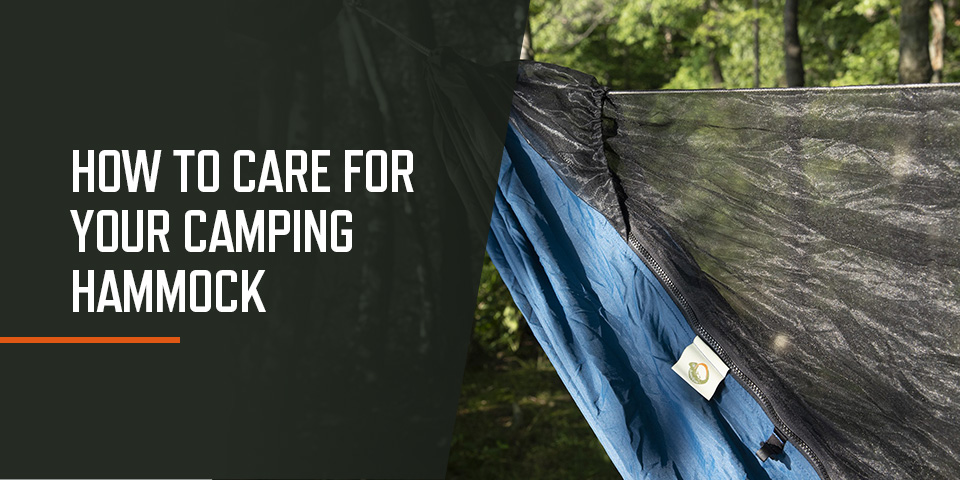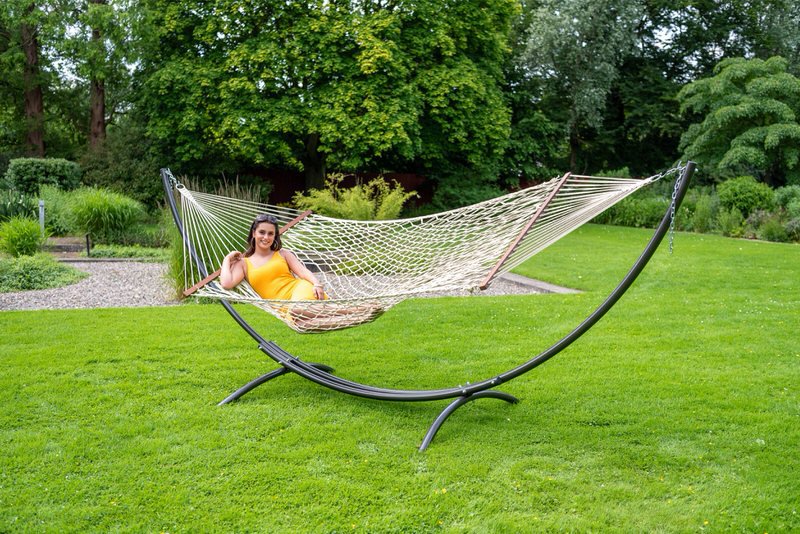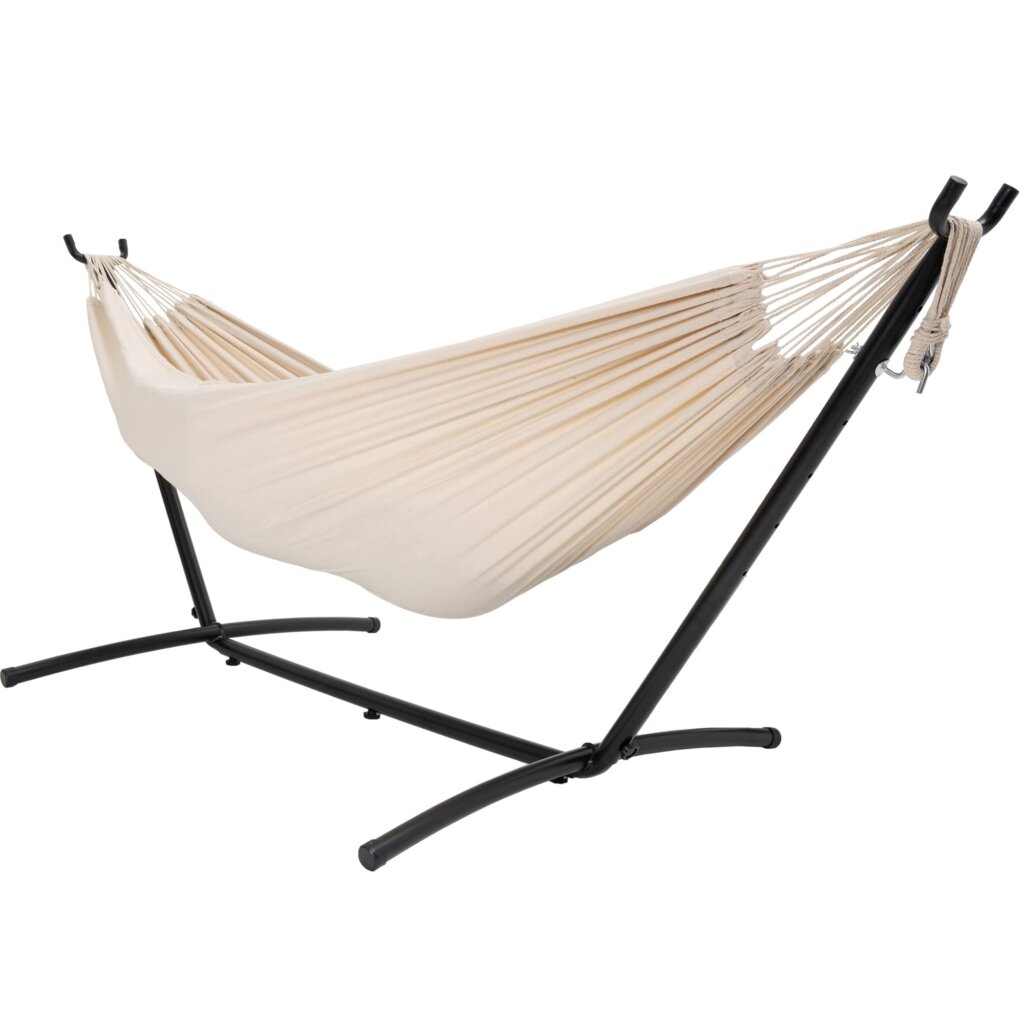- 8 Airplane Footrest Hammock!Travel comfortably - October 9, 2023
- top 7 Pool Float Water Hammock for a Relaxing Summer - October 9, 2023
- top 5 Space SaverSingle Hammock Stand Maximize Comfort and Space - October 9, 2023
To clean a hammock swing, you can wash it in a washing machine with mild detergent on a gentle cycle. Make sure to never use bleach and only wash the hammock.
Alternatively, you can mix mild soap with warm water and scrub the rope with a soft bristle brush. Start by applying the soapy water to one section at a time. Remember to thoroughly dry the hammock before storing or using it again.
Preparing For Cleaning
Preparing for Cleaning
To keep your hammock swing in perfect condition and extend its lifespan, regular cleaning is essential. Before you begin the cleaning process, make sure you gather all the necessary cleaning supplies. Removing any accessories attached to the hammock is also essential to ensure a thorough cleaning. Finally, choose a suitable location for cleaning that provides enough space to maneuver the hammock and allows for easy drying. Follow these steps to prepare for a successful hammock swing cleaning.
Gather necessary cleaning supplies
Before you start cleaning your hammock swing, it’s important to gather all the necessary cleaning supplies. Here’s a list of items you’ll need:
- Mild detergent
- Warm water
- Bucket or large container
- Soft-bristled brush
- Clean cloth or sponge
Having these supplies ready will ensure a smooth cleaning process.
Remove any accessories attached to the hammock
To clean your hammock swing effectively, it’s important to remove any accessories attached to it. These can include pillows, cushions, or any other decorative items. Removing the accessories not only allows for a thorough cleaning but also prevents any potential damage to them during the cleaning process. Store these accessories in a safe place until the cleaning is complete.
Choose a suitable location for cleaning
Selecting the right location for cleaning your hammock swing is crucial for convenience and efficiency. Look for a location that provides ample space to maneuver the hammock and allows for easy drying. A backyard or patio area with enough clearance is ideal. Additionally, consider placing a tarp or plastic sheet underneath the hammock to protect the ground or floor from any dirt or moisture.
Once you’ve collected the necessary cleaning supplies, removed any accessories, and chosen a suitable location, you’re ready to proceed with cleaning your hammock swing. Following these steps will ensure that your hammock swing is clean and ready for many more hours of relaxation.
Cleaning A Fabric Hammock
Shake off loose debris and dirt
To clean a fabric hammock, the first step is to shake off any loose debris and dirt. This can be done by simply holding the hammock by the ends and giving it a few gentle shakes. This will help to remove any leaves, branches, or other loose particles that may have accumulated on the surface of the fabric. By doing this, you will ensure that the cleaning process is more effective and that the dirt does not get pushed further into the fabric.
Spot clean stubborn stains
If your fabric hammock has any stubborn stains that cannot be removed by shaking, it’s time to spot clean. Spot cleaning involves targeting specific areas of the hammock that are stained or soiled. To do this, you can use a mild detergent or stain remover. Apply a small amount of the cleaning solution directly to the stain and gently scrub it with a soft-bristled brush. Be sure to use gentle motions to avoid damaging the fabric. Once the stain has been treated, rinse the area thoroughly with water.
Prepare a mild cleaning solution
Before proceeding with the overall cleaning of the fabric hammock, it is necessary to prepare a mild cleaning solution. This solution will help to remove dirt, debris, and any remaining stains. To create the cleaning solution, mix a few drops of mild detergent with warm water in a bucket or basin. Stir the mixture until the detergent is well-dissolved. It is important to use a mild detergent as harsh chemicals can damage the fabric and cause discoloration.
Scrub the hammock with a soft-bristled brush
Once the mild cleaning solution is ready, it’s time to start scrubbing the fabric hammock. Dip a soft-bristled brush into the cleaning solution and start scrubbing the hammock in gentle circular motions. Pay special attention to areas with visible stains or dirt buildup. Be sure to cover the entire surface of the hammock, including the edges and corners. If there are any areas that require extra cleaning, apply a bit more cleaning solution and continue scrubbing until the dirt and stains are removed.
Rinse thoroughly with water
After scrubbing the fabric hammock, it is important to rinse it thoroughly with water. This will help to remove any leftover cleaning solution and ensure that no residue remains on the fabric. Use a hose or a bucket of water to rinse the entire hammock, making sure to reach all areas and remove any soap suds. The water should be clear and free of any detergent or cleaning solution. Rinse until the water runs clear and the hammock feels clean to the touch.
Allow the hammock to air dry completely
Lastly, it is crucial to allow the fabric hammock to air dry completely. Hang the hammock in a well-ventilated area, preferably outdoors, so that it can dry naturally. Ensure that the hammock is stretched out evenly to prevent any wrinkles or creases from forming. It is important to avoid using a dryer or placing the hammock in direct sunlight as this can cause damage to the fabric. Once the hammock is completely dry, it can be safely stored or ready for use again.
Cleaning A Nylon Hammock
Shake off loose debris and dirt
To begin cleaning a nylon hammock, start by shaking off any loose debris and dirt. This will help remove any surface-level dirt that may be clinging to the hammock. Give the hammock a gentle shake to dislodge any loose particles. You can also use a soft brush or broom to brush off any remaining debris.
Spot clean stubborn stains with a mild detergent
If you notice any stubborn stains on your nylon hammock, spot cleaning is the way to go. Mix a mild detergent with warm water and create a soapy solution. Take a clean cloth or sponge and dip it into the soapy solution. Gently dab the stained area, being careful not to scrub too hard and damage the fabric. Rinse the cloth or sponge thoroughly and continue dabbing until the stain is lifted.
Prepare a bucket of warm, soapy water
Before immersing your entire nylon hammock in water, it’s important to prepare a bucket of warm, soapy water. Fill a large container or bucket with warm water and add a small amount of mild detergent. Stir the solution gently to ensure the soap is dissolved evenly in the water.
Submerge the hammock in the soapy water
Once the soapy water solution is prepared, submerge the nylon hammock into the water. Fully immerse the hammock and ensure that it is completely soaked in the soapy solution. Allow the hammock to sit in the water for a few minutes to loosen any dirt or grime that may have accumulated.
Scrub the hammock with a soft brush
After the hammock has soaked in the soapy water for a few minutes, take a soft brush and gently scrub the fabric. Use a back and forth motion to work the soap into the fabric and remove any dirt or stains. Be sure to pay extra attention to areas that are visibly dirty or stained.
Rinse thoroughly with water
Once you have finished scrubbing the hammock, it’s time to rinse off the soap. Use a hose or a bucket of clean water to thoroughly rinse the hammock. Make sure to rinse all areas of the hammock to ensure that all soap residue is removed.
Hang the hammock to air dry completely
After rinsing, hang the nylon hammock in a well-ventilated area to air dry completely. It’s important to ensure that the hammock is fully dry before storing or using it again to prevent mold or mildew growth. Make sure that the hammock is hung evenly to allow for proper air circulation and drying.
In conclusion, cleaning a nylon hammock involves shaking off loose debris, spot cleaning stubborn stains, preparing a soapy water solution, submerging the hammock, scrubbing gently with a soft brush, rinsing thoroughly, and hanging the hammock to air dry completely. Following these steps will help keep your nylon hammock clean and in good condition for many enjoyable swings to come.

Credit: dutchwaregear.com
Cleaning A Hammock With Spreader Bars
When it comes to enjoying a comfortable and relaxing swing on your hammock with spreader bars, it’s important to keep it clean and well-maintained. Regular cleaning not only ensures a longer lifespan for your hammock but also keeps it looking fresh and inviting. Cleaning a hammock with spreader bars is a fairly simple process that can be done with just a few basic supplies. In this article, we’ll walk you through the step-by-step process of cleaning your hammock with spreader bars to keep it looking and feeling its best.
<h3 id=”remove-the-spreader-bars-from-the-hammock”>Remove the spreader bars from the hammock</h3>
The first step in cleaning your hammock is to remove the spreader bars. This allows for easier handling and cleaning of the fabric. Carefully detach the spreader bars from the hammock by following the manufacturer’s instructions or loosening the fasteners holding them in place. Once removed, set them aside for cleaning later.
<h3 id=”shake-off-loose-debris-and-dirt”>Shake off loose debris and dirt</h3>
Before diving into a thorough cleaning, start by shaking off any loose debris and dirt from the hammock fabric. Take the hammock to an open area and gently shake it to dislodge any leaves, twigs, or other debris that may have accumulated. This initial step helps to minimize the amount of dirt that needs to be scrubbed off later.
<h3 id=”spot-clean-any-stains-on-the-hammock-fabric”>Spot clean any stains on the hammock fabric</h3>
If you notice any specific stains or spots on the hammock fabric, it’s best to spot clean them before proceeding with a full cleaning. Prepare a mild cleaning solution by mixing warm water with a gentle detergent. Dip a clean cloth or sponge into the solution and gently blot the stained areas. Avoid rubbing vigorously as it may damage the fabric. Rinse the cloth or sponge and blot again with clean water to remove any soap residue.
<h3 id=”prepare-a-mild-cleaning-solution”>Prepare a mild cleaning solution</h3>
Next, it’s time to prepare a mild cleaning solution for the overall cleaning of the hammock fabric. Fill a bucket with warm water and add a small amount of mild detergent. Mix the solution well to create a soapy mixture. This gentle cleaning solution is effective in removing dirt and grime without causing damage to the hammock fabric.
<h3 id=”scrub-the-fabric-with-a-soft-bristled-brush”>Scrub the fabric with a soft-bristled brush</h3>
Dip a soft-bristled brush into the mild cleaning solution and start scrubbing the hammock fabric. Work in small sections, applying light pressure and using gentle circular motions. Pay attention to areas that may have accumulated more dirt, such as the footrest or headrest. Be thorough but avoid scrubbing too vigorously, as it may cause the fabric to fray or tear.
<h3 id=”rinse-thoroughly-with-water”>Rinse thoroughly with water</h3>
Once you’ve finished scrubbing the fabric, it’s time to rinse off the soapy residue. Use a hose or clean bucket of water to thoroughly rinse the entire hammock. Make sure to rinse off all the soap suds until the water runs clear. This step helps to prevent any leftover cleaning solution from causing damage or discoloration to the fabric.
<h3 id=”clean-the-spreader-bars-using-a-damp-cloth”>Clean the spreader bars using a damp cloth</h3>
While the hammock fabric is drying, take the opportunity to clean the spreader bars. Using a damp cloth, wipe down the bars to remove any dirt or grime that may have accumulated. Pay attention to any crevices or corners where dirt may be trapped. Once cleaned, set the spreader bars aside to air dry with the hammock fabric.
<h3 id=”allow-the-hammock-and-spreader-bars-to-air-dry-completely”>Allow the hammock and spreader bars to air dry completely</h3>
Finally, it’s important to allow both the hammock fabric and spreader bars to air dry completely before reassembling and using your hammock. Hang the hammock in a well-ventilated area, preferably outdoors, and ensure that it is completely dry before storing or using it again. Similarly, place the cleaned spreader bars in a dry area and allow them to air dry thoroughly.
By following these simple steps to clean your hammock with spreader bars, you can ensure it remains in great condition and provides a comfortable and enjoyable experience every time. Regular cleaning and maintenance will not only extend the lifespan of your hammock but also keep it looking and feeling fresh for years to come.
Cleaning A Hammock With Moldy Rope
When it comes to properly maintaining your hammock, cleaning it regularly is essential. Moldy rope can not only affect the aesthetics of your hammock, but it can also compromise its durability and performance. To keep your hammock in pristine condition, follow these simple steps to effectively clean a hammock with moldy rope:
Remove the hammock from the hanging location
The first step in cleaning a hammock with moldy rope is to remove it from its hanging location. This will ensure that you have easy access to all areas of the hammock for a thorough cleaning.
Shake off loose debris from the hammock
Once the hammock is removed, give it a good shake to remove any loose debris such as leaves, twigs, or dirt. This will make the cleaning process easier and more effective.
Prepare a cleaning solution with warm water and mild detergent
In a large container or bathtub, fill it with warm water and add a small amount of mild detergent. Mix it well until it creates a soapy solution. Make sure to choose a mild detergent that is gentle on the hammock material.
Scrub the moldy rope with a soft brush
Dip a soft-bristled brush into the cleaning solution and start scrubbing the moldy rope of the hammock. Pay extra attention to the areas that are visibly affected by mold or mildew. Use gentle circular motions to remove the mold and grime.
Rinse the rope thoroughly with water
Once you are satisfied with the scrubbing, rinse the rope thoroughly with clean water. This will help remove any remaining soap residue and ensure that the rope is clean and fresh.
Hang the hammock to air dry completely
After rinsing, hang the hammock in a well-ventilated area to air dry completely. Make sure that it is fully supported and not touching the ground to prevent any additional dirt or moisture. Allow the hammock to dry completely before storing or using it to ensure that no moisture is trapped, which can lead to mold growth.
By following these simple steps, you can effectively clean a hammock with moldy rope and ensure its longevity and cleanliness. Regular maintenance and cleaning are key to enjoying your hammock swing for years to come.
Tips For Maintaining A Clean Hammock
Keeping your hammock clean is essential for its longevity and your comfort. Regular maintenance can help prevent mold, mildew, and general wear and tear. Here are some tips to ensure your hammock stays fresh and clean for years to come.
Regularly shake off loose debris and dirt
To start, it’s important to regularly shake off any loose debris or dirt from your hammock. This can be done by simply hanging it up and vigorously shaking it. By doing this, you remove leaves, twigs, and other small particles that may have accumulated after each use. Additionally, shaking off loose debris helps to prevent stains and make the cleaning process easier.
Spot clean stains promptly
If you notice any stains or spills on your hammock, it’s crucial to spot clean them promptly. Leaving stains on the fabric or rope for an extended period can cause discoloration and potentially lead to a more difficult cleaning process. For most hammocks, a mixture of mild soap and warm water will suffice for spot cleaning. Gently scrub the stained area with a soft bristle brush, working the soapy solution into the fabric or rope. Rinse well with clean water and allow it to air dry thoroughly before use.
Avoid using bleach or strong chemicals
When it comes to cleaning your hammock, it’s best to avoid using bleach or strong chemicals. These harsh substances can damage the fabric or weaken the rope, compromising the integrity of your hammock. Stick to milder cleaning agents such as mild soap or gentle laundry detergent, diluted with water. Not only are these options safer for the material, but they are also more environmentally friendly.
Ensure the hammock is completely dry before storing
Before storing your hammock, it’s crucial to ensure that it is completely dry. Moisture left in the fabric or rope can lead to the growth of mold or mildew, which not only affects the cleanliness but also the overall durability and longevity of your hammock. Hang it in a well-ventilated area or use a drying rack to allow proper air circulation. Once your hammock is thoroughly dry, you can fold it carefully for storage.
Store the hammock in a dry and protected area
Lastly, it’s important to store your hammock in a dry and protected area. Extreme weather conditions, such as excessive sun exposure or heavy rainfall, can damage the fabric or rope over time. Choose a storage location that is shielded from direct sunlight and moisture, such as a covered patio or a storage bag. Storing your hammock properly ensures that it stays clean and ready for use whenever you need it.
Frequently Asked Questions Of How To Clean Hammock Swing
How Do You Deep Clean A Hammock?
To deep clean a hammock, follow these steps:1. Machine wash it in a gentle cycle with mild detergent. Avoid using bleach. 2. Scrub the hammock with warm, soapy water and a soft-bristled brush to remove mildew. 3. Rinse the hammock thoroughly.
4. Hang it to dry completely before storing or using again. 5. For rope or fabric hammocks, use a mild detergent and a soft-bristled brush to scrub off dirt and debris. Rinse and dry afterwards.
Can I Put My Hammock In The Wash?
Yes, you can wash your hammock in a washing machine. Use mild detergent and the gentle cycle. Never use bleach and only wash your hammock. If your hammock has mold, use warm soapy water and scrub with a soft bristled brush.
Can You Wash A Moldy Hammock?
Yes, you can wash a moldy hammock. Fill a bucket with warm, soapy water and scrub the hammock with a soft-bristled brush. Make sure to clean all areas, especially if there is a spreader bar. Rinse well and let it dry completely before using or storing.
How Do You Clean A Moldy Hammock?
To clean a moldy hammock, mix mild soap with warm water. Pour the mixture on the hammock section by section. Use a soft bristle brush to scrub the rope gently. Repeat this process until the entire hammock is clean. Make sure to thoroughly dry it before storing or using it again.
Avoid using strong chemicals or bleach.
How Can I Deep Clean My Hammock?
To deep clean your hammock, you can either hand wash it in lukewarm water with mild detergent or machine wash it on a gentle cycle. Avoid using bleach and wash only your hammock.
Can I Wash A Moldy Hammock?
Yes, you can clean a moldy hammock using warm, soapy water and a soft-bristled brush. Scrub the hammock, especially if it has a spreader bar, and remove the mildew with some good old elbow grease.
Conclusion
To keep your hammock swing clean and well-maintained, follow these easy steps. You can either machine wash it using a gentle cycle and mild detergent, or hand wash it with warm water and a soft-bristled brush. Avoid using bleach and make sure to scrub any mildew or mold if present.
Once clean, let it air dry completely before storing it. By following these cleaning tips, you can ensure that your hammock swing stays in great condition for years to come.






Pingback: Should I Leave My Hammock Outside? (Storage Guide)
Pingback: Top 5 Space Saver Single Hammock Stand Maximize Comfort And Space